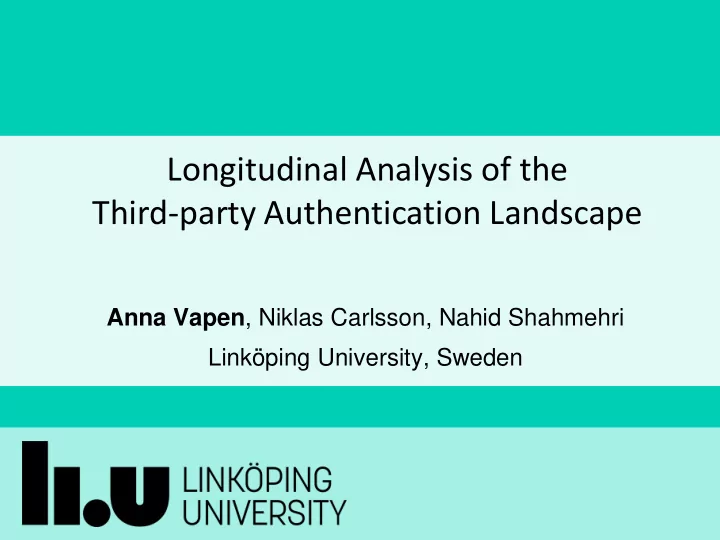

Longitudinal Analysis of the Third-party Authentication Landscape Anna Vapen , Niklas Carlsson, Nahid Shahmehri Linköping University, Sweden
2 Background: Third-party Web Authentication Web Authentication • Registration with each website • Many passwords to remember Third-party authentication • Use an existing IDP (identity provider) account to access an RP (relying party) • Log in less often; Stronger authentication • Share information between websites • Information sharing privacy leaks!
3 Third-party Authentication Scenario Redirect Identity provider (IDP) Logged in Relying party (RP) Relationship between RP and IDP
4 Putting the Work in Context • Our previous work – Large-scale study on the RP- IDP landscape (PAM’14) – Categorization of RPs (IEEE IC’16) – Detailed study on information flows (SEC’15) Current longitudinal study • – How has the RP-IDP landscape changed over time? – Privacy implications of landscape structure? – Changes in information flows over time?
5 Contributions 1. Structural dynamics – Structural model of the RP-IDP landscape 2. Protocol-based analysis – Protocol- and IDP changes vs. popularity changes 3. Flow-based analysis of privacy risks Information leaks between RPs and IDPs –
6 Methodology • Top 200 most popular websites – Measured at ten points in time, April 2012 to April 2015 – Original top 200 sites from April 2012, over time – Current top 200 at a specific time of measurement Original Current top 200 snapshots top 200 • Data flow analysis of sites using top IDPs (2014-2015) Facebook permission agreements •
Structural dynamics 7 Popular IDPs Top 200 April 2012: 69 RPs and 180 relationships Same sites, April 2015: +15 RPs and +33 relationships
Structural dynamics 8 Popular IDPs Increased in popularity Decreased in popularity
Structural dynamics 9 Structures in the RP-IDP Landscape IDP IDP IDP 1 IDP 2 Hybrid: HY RP and IDP RP 1 RP 2 RP RP High-degree IDP case High-degree RP case • • RP having many IDPs IDP having many RPs Hybrid case • • Specialized IDPs Top IDPs • Hybrids are both RP and IDP
Structural dynamics 10 Structural Model • We have modeled the landscape as a bipartite graph – Mainly high-degree IDP structures IDP Upper layer IDP HY Lower layer RP 1 RP 2 RP
Structural dynamics 11 Structural Model Place HY nodes in layers, based on their main feature IDP IDP IDP 1 2 IDP IDP 1 2 HY IDP HY HY RP RP RP HY 1 2 RP RP RP 1 2
Structural dynamics 12 Structural Changes • Three stages of the landscape: 1. Adding many IDPs (trying out new technology) 2. Nested landscape with many hybrids 3. Simplified landscape • Regional and language-based differences: – English/US Web: Stage 3 with few IDPs – Chinese Web: Stage 3, still with many hybrids – Russian Web: Entering stage 2!
Structural dynamics 13 Example: Structural Changes Non-Chinese Web April 2012: IDP-like hybrids (few) Non-Chinese Web April 2015: Emerging Russian HY-structures
Protocol-based analysis 14 Relationship Types • Relationship types: – Stable: Kept by the RP, during all 10 snapshots – New: Added after the first snapshot – Removed: Observed in the 1 st snapshot and later removed – Changing: Added and removed one of more times Changing Removed New Stable
Protocol-based analysis 15 Protocol Usage per Relationship Type OAuth protocol: Less privacy preserving than OpenID! * Parts of the Chinese OAuth relationships may be internal
Protocol-based analysis 16 RP Behavior The IDP owns the RP All relationships (e.g., Google owns Youtube) are stable IDP Selection Non-Chinese Web Stable New RP Expanding Removed relationships Reduced/fluctuating and/or had a fluctuating RP owned by IDP set of IDPs Became RP after 1 st measurement Started with a set of IDPs and added more IDPs
Flow-based analysis 17 Information Sharing Between RP and IDPs IDP1 Permission agreement Relying party (RP) IDP2
Flow-based analysis 18 Types of Information Flows READ: RP acts on behalf of the user Data read from IDP to RP IDP on the IDP Rich user data, contents created by the user (images, videos, “likes” etc). WRITE: RP Data posted by RP on IDP Notifications, or created contents UPDATE/REMOVE: Other actions taken on the IDP The RP can add the user to groups and modify the user’s IDP account
Flow-based analysis 19 Potential Information Leaks • Single-hop data transfer: RP to IDP (or IDP to RP) • Multi-hop leak: Indirect leak via proxy node(s) IDP IDP IDP 1 IDP 2 IDP HY RP RP 1 RP 2 RP RP Single-hop RP-to-RP IDP-to-IDP Hybrid structures
Flow-based analysis 20 RP-to-RP Leakage Example RP-to-RP leaks February 2014 April 2015 IDP IDP All Severe All Severe Facebook 645 150 473 66 Twitter 110 110 110 110 RP 1 RP 2 Google 91 0 91 0 Dataset with 44 RPs using Facebook, 14 using Twitter RP-to-RP and 12 using Google • Potential RP-to-RP leaks – Information written/posted from RP1 to IDP – Information read from IDP to RP2 – Leak only possible with Write(RP1-IDP) + Read(IDP-RP2)
Flow-based analysis 21 Facebook Use-case • Facebook API changes in 2015 to strengthen privacy – Most RPs needed to change to more privacy-preserving data sharing permissions to comply – Four measurements: Sept. 14 – May 2015 – 63 top-200 RPs using Facebook as their IDP Changed permissions Did not update API or before updating API change permissions! Already complied with Changed API and new permissions permissions at same time Complying Pro-active RPs Changed permissions Late adopters 0% 20% 40% 60% 80% 100%
22 Contributions and Findings • Showed that the RP-IDP landscape can be modeled as a bipartite graph – Designed a model for RP-IDP structures – Identified structural changes over time Protocol- and IDP selections made by RPs • A few popular IDPs increasingly used – More data sharing – less user privacy – • Identified privacy leakage risks – Multi-hop, enabled by the structures
Longitudinal Analysis of the Third-party Authentication Landscape Anna Vapen, Niklas Carlsson, Nahid Shahmehri anna.vapen@liu.se
Recommend
More recommend